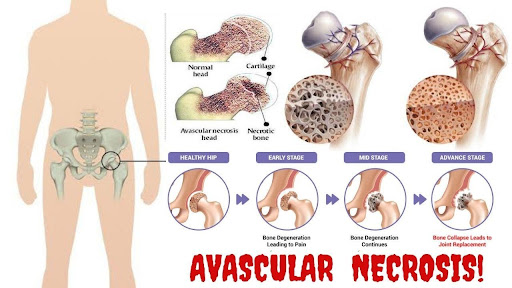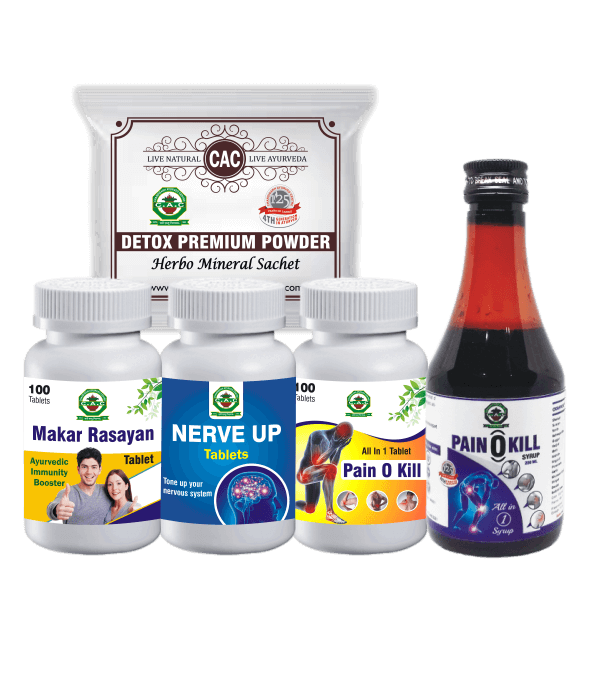
AVASCULAR NECROSIS
- March 2, 2023
- Posted by Dr. Vaidya Karanvir Singh
- 0 Comment(s)
Table of Contents
INTRODUCTION
Avascular necrosis is defined as the death of bone tissue due to loss of blood supply to it. It is also known as osteonecrosis or ischemic bone necrosis. Due to lack of blood supply, the bone tissue does not get nutrition and starts deteriorating. There occur cracks in the bone and with time the bone collapse. The bone death takes either in some months or a few years. Fracture of bone or dislocation of any joint can lead to stoppage of blood flow to a section of bone. Also prolonged use of steroids is also responsible for avascular necrosis. Avascular necrosis mostly affects hip joint. However, other possible areas can be knees, ankles and shoulder. People of all age groups are affected but people between the age group of 30 to 50 years are more commonly affected. In most of the cases, treatment involves surgery, that is, joint replacement.
WHAT ARE THE CAUSES OF AVASCULAR NECROSIS?
Avascular necrosis occurs when there is reduced blood flow or no blood flow at all to the bony tissue. The body makes new bony tissue to replace the aging old bone tissue. The old bony tissue breaks down and eventually dies. This cycle helps in keeping the bones strong and healthy. Blood helps in giving required nutrients to the bones and also provides them oxygen. When the blood supply is blocked, the tissue doesn’t get proper nutrition and it starts dying. With time, the bone crumbles and collapses. The reasons which are responsible for avascular necrosis are:
Any physical trauma leading to fracture or dislocation of bone
- Osteomyelitis
- Osteoporosis
- Deposition of fat along the walls of blood vessels
- Radiation therapy
- Sickle cell anemia
- Paget’s disease
- Pancreatitis
- AIDS
- Systemic lupus erythematosus
- Blood cancer
WHAT ARE THE RISK FACTORS OF AVASCULAR NECROSIS?
Some factors increase the risk of a person developing avascular necrosis. Following are the risk factors of avascular necrosis:
- Excessive alcohol intake
- Organ transplants
- Use of bisphosphonate drugs
- Prolonged use of steroids
- Diabetes
- Inflammation of blood vessels
- Cancer treatment
WHAT ARE THE SIGNS AND SYMPTOMS OF AVASCULAR NECROSIS?
In the early stages, there is no appearance of symptoms. But as time passes, the affected bone damages leading to appearance of symptoms. Following are the common signs and symptoms of avascular necrosis:
- Pain when there is increased pressure on the bone
- Swelling and joint stiffness
- Decreased range of motion
- Difficulty in standing and walking
- Difficulty in climbing stairs
- Limping if hip or knee joint is affected
HOW AVASCULAR NECROSIS CAN BE PREVENTED?
Avascular necrosis cannot be prevented but by following some of the steps, it can be kept at bay. Following are the steps which are beneficial for prevention of avascular necrosis:
- Say no to alcohol
- Do regular physical exercise
- Maintain healthy body weight
- Keep a check on steroids
- Avoid smoking
- Maintain blood cholesterol level
MANAGEMENT OF AVASCULAR NECROSIS WITH THE MEDICINES OF AVASCULAR NECROSIS
Here are some of the medicines of Chandigarh Ayurved centre which are used for the treatment of avascular necrosis:
1. Detox Premium Powder
The powder is very beneficial to cure any body pain as it removes excess toxins from the body and balances the aggravated pitta and vata dosha. It consists of several herbs and bhasmas such as shukta pishti, giloy satv, parwal pishti, kamdudha rasa, moti pishti, gandhak rasayan, akik pishti, etc. The ingredients help in reducing swelling, redness, shrinkage of tear lining in the anus, burning sensation, etc.
Recommended Dosage: Take one sachet twice daily.
2. Makar Rasayan Tablet
Makar Rasayan tablet is a herbo-mineral tablet and is purely Ayurvedic formulation. CAC MAKAR RASAYAN tablet help in balancing all the three doshas. It helps to rejuvenate body tissues and act as an immuno modulator. It helps in proper blood circulation. It prevents the skin from dryness. It contains natural ingredients like shudha kuchla, guduchi satva, shudha shilajeet, ras sindoor, moonga bhasma, shankh bhasma, praval pishti etc. Herbs and minerals used for the formulation of these tablets show antioxidant, aphrodiasic, analgesic and immuno modulator properties.
Recommended Dosage– Take 1 tablet twice a day with normal water.
3. Nerve Up Tablet
Nerve up tablet is a herbo-mineral tablet and is purely ayurvedic formulation. CAC Nerve up tablets help in balancing the vata doshas. It reduces kapha dosha, and acts as nervine stimulant. It shows effective results in improving the central nervous system. It contains natural ingredients like shudha kuchala, shudha shilajeet, praval pishti, shankh bhasma etc. These contains natural vatahar properties and helps in curing vata diseases.
Recommended Dosage– Take 1 tablet twice a day with normal water.
4. Pain-O-kill Tablets
As the name suggests these tablets will kill the pain naturally. The herbs present in the formation of these tablets are Ashwagandha, Hadjod, Punarnava, Nirgundi, Methi, Garlic, etc. These herbs in combination show antioxidant, analgesic, anti-inflammatory, immuno-modulator properties. The regular use of these tablets reduce body pain and acts on its root cause.
Recommended Dosage: Take 1 tablet twice daily with normal water.
5. Pain-O-kill Syrup
The herbal syrup is prepared from ingredients like Shunthi, Shudh Guggulu, Ashwagandha, Hadjod, Nirgundi, etc that reduces pain naturally. This herbal syrup helps to reduce body pain, muscle stiffness, inflammation, & swelling. The ingredients used for the preparation of the syrup possess antioxidant, analgesic, anti-inflammatory, etc properties.
Recommended Dosage: Take 2 teaspoonfuls twice daily.

Dr. Vaidya Karanvir Singh is the younger Vaidya in Chandigarh Ayurved & Panchakarma Centre. He is the fourth generation in his family who is practicing as a general consultant in Ayurved & Panchakarma treatment at Chandigarh. In his practice, he had treated more than 1 Lakh Plus patients worldwide.


